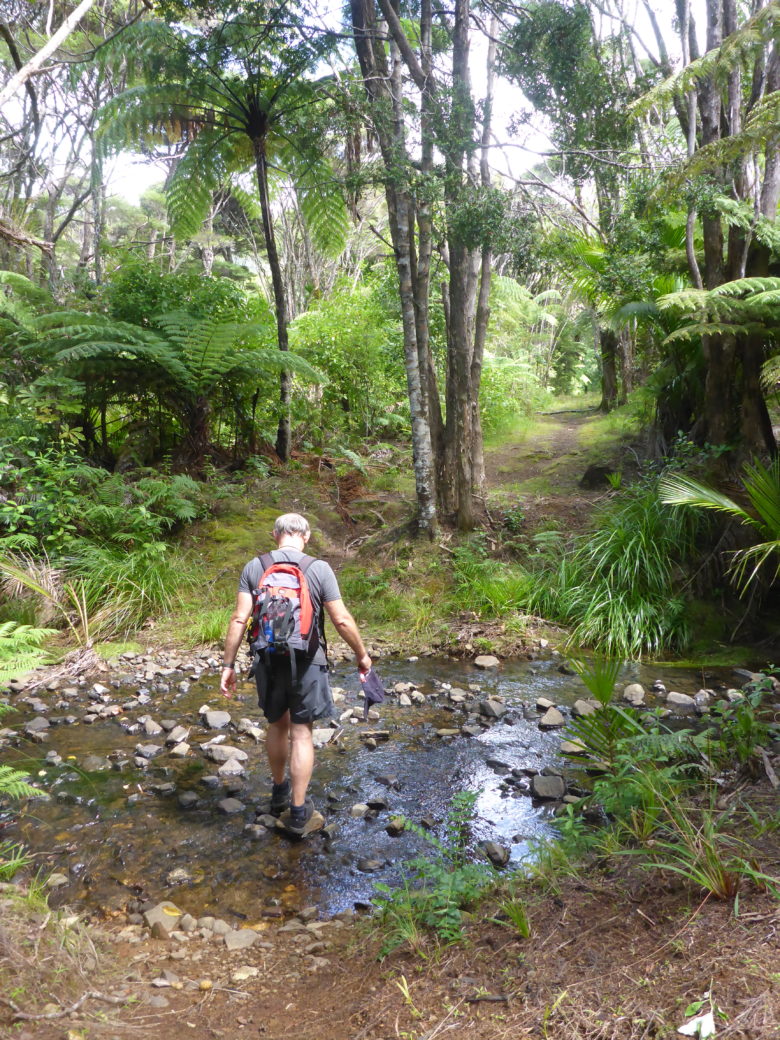Post Cyclone Gita we leave the Main (land) for Great Barrier Island
‘Self-Evacuate’ (sounds like a meteorological enema doesn’t it) is a term that has been used as advice to folk to leave their homes in the path of Gita for a safe haven before the storm arrived. Six thousand folk found themselves trapped in Golden Bay on the north-west coast of the South Island by massive landslips and barges are having to be employed to ferry them out and food supplies in to the area. You certainly get some weather here.
For us on Zoonie the fridge man came and now we have the sweet sound of it turning itself on for a few seconds in every ten minutes and then silence. The verdict, it was over-gassed and the higher the gas pressure the higher the temperature in the fridge, which is why apart from it not turning off it didn’t seem to be doing its job of cooling either!
The day after this pleasing event Zoonie left Whangarei Marina, refuelled in Marsden Marina, where we cleared in to NZ 16 months ago, turned left at number 9 starboard hand buoy and anchored for the night in Urquarts Bay near Bream Head ready for an early start the next morning. It was the 22nd February 2018.
Kaiarara Bay 36’11’S 175’22’E
The anchor went down at 17.30 under the soulful wooded gaze of Mount Hobson after a pleasant motor sail with light winds lasting 10 hours. The chartplotter showed a hardware fault with the AIS which will have to be fixed.
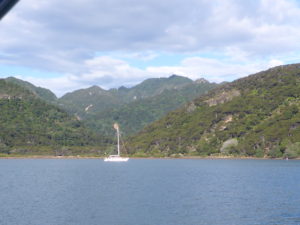
We waited with Zoonie for the urge to go ashore and explore to become sufficiently strong and overcome the pleasure of just sitting at anchor once more. The wind blew and the sun shone to give us plenty of electricity.
Two pretty little chestnut Brown Teal ducks came alongside and were so tame I wondered if they had been bred in captivity as they are nationally endangered. I read somewhere that there is an abundance of birdlife on Great Barrier but what we noted was the variety and not an abundance of any particular type apart from fantails, gannets crashing into the water and sacred kingfishers. The little teals’ predators are skuas who lie in wait for them to come ashore and then attack them. So mean.
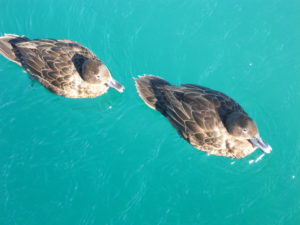
25th February. Mt Hobson, Hirakimata the Sacred Mountain to the Maoris, at 627 metres and here we come. I still haven’t discovered who ‘Hobson’ was. Captain William Hobson arrived in The Bay of Islands aboard HMS Herald on the 29th January 1840 to carry out the Order from the British Government to annex New Zealand as a colony of New South Wales to protect it from foreign intervention. Along with James Busby, the British Resident and two officers from the Herald, Hobson drafted and corrected the highly contentious Treaty of Waitangi, from Struggle Without End by Ranginui Walker 2004.
Mercifully the day was cloudy and the ground dry. The path was good and well maintained and standing on the stout bridges let us imagine the route of the mighty kauris as they tumbled noisily downstream, their long lives over. The remnants of two of the kauri dams remain. They are horizontal stringer dams and although the one in the photograph was rebuilt in 1998 a weather bomb hit the island in 2014 and what you see now is all that is left.
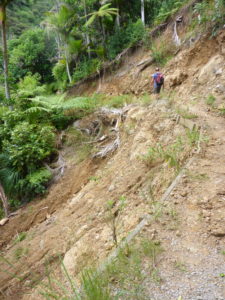
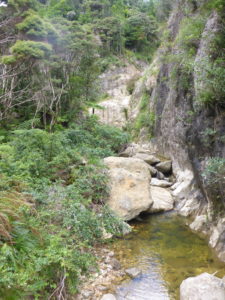
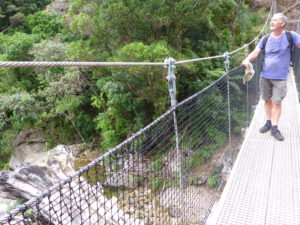
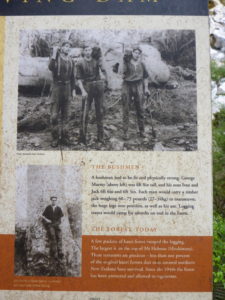

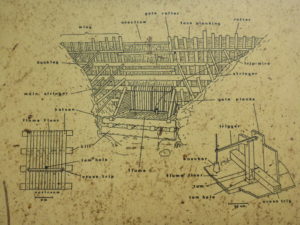
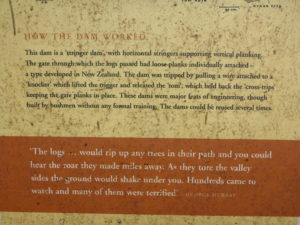
We met three energetic Auckland ladies at the dam who were doing the popular Aotea 3 day hike. Such a remote and beautiful place for the exploration by city dwellers just a short flight away is a real gift and these ladies thoroughly appreciated it.
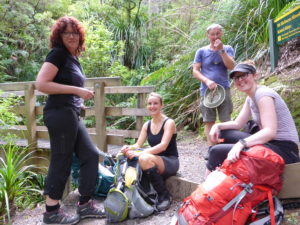
The water would build up behind the dams, elevating the trunks from the uneven riverbed and hundreds of folk used to gather to watch as the spring was pulled from the trap door and with terrifying thunder and ground vibration the load would be released. What a spectacle!
Regular climbs to the Parihaka lookout back in Whangarei had kept us reasonably fit for this 7km climb up and down, across slips and finally up hundreds (someone counted 2600) of wooden steps as steep as a step ladder to the tiny wooden platform on top from where we had fantastic 360’ views from the blue south pacific ocean in the east to the Hauraki Gulf southwestwards, from the northern tip of the Coromandel Peninsula to the Poor Knights in the north, of snorkelling with Charly and Tom memories.
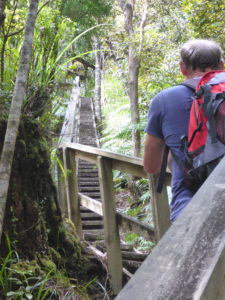
A charming French couple who had moored alongside us in Whangarei and anchored nearby here joined us as we sat dangling our legs over the edge of the wooden platform and ate our lunch.


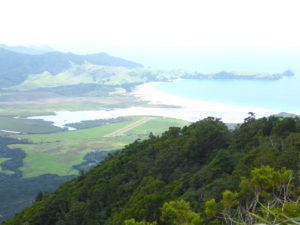
The raucous cry of the brown parrot, the kaka, that tuneful call of the tui and the frantic twitter of fantails filled the lush re-growth of bush as we returned downwards.
Some kauris remain, maybe too hard to harvest and of course the young ones back then that weren’t worth felling have grown since. Also back in the 70’s and 80’s when the island was home to many hippy communes, 150,000 kauri seedlings were planted but we have yet to find them. How will they do with the kauri die-back disease that is decimating the few remaining groves?
I rowed back to Zoonie as the outboard motor has decided to squirt its fuel from the top of the carburettor in protest at being asked to work. We swam around Zoonie to refresh ourselves and spent the next day communing with the teals while languishing on board in the smug knowledge that another mount had been conquered.
To Whangaparapara Bay 36’15S 175’24’E
The journey from our first bay to this one was an unexpected pleasure of birdlife. Numerous little groups of Little Blue Penguins showed just above the water surface and dived before I could ever get a photo of them. I thought they only lived on the South Island, where we had seen them on the Otago Peninsula. To see them in such numbers was a delight, especially as they have had a poor breeding season due to the king tides combined with cyclones having floated most of their nests away.
On a rocky island a gannet colony thrived well above the high tide level and the craggy, crack riddled nature of the rocks provided numerous nesting opportunities for other birds.
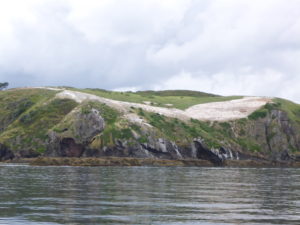
Shearwater and rare black petrels swooped around us as we approached our bay which was graced with the presence of the beautiful square-sail schooner, Spirit of New Zealand. I asked one of her volunteer crew, “Is she a topsail schooner?”
“I have no idea.” Was her reply. She had four square sails on her foremast anyway.
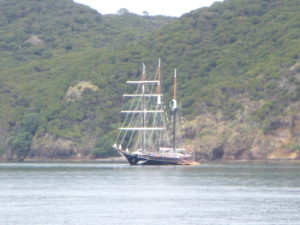
Whangaparapara Bay has borne witness to phenomenal phases of industry in the past 200 years from the major industries of timber extraction and milling and whaling to smaller concerns like gum digging, gold mining and illicit distilling of moonshine.
Way back in 1769 during his first explorative circumnavigation Captain Cook was venturing slowly around the Coromandel peninsula area a few miles to the south west from here with his crew aboard The Endeavour. He went ashore in one place and using his quadrant he was able to report the dimensions of a tree he found. It had a girth of 19 feet 8 inches when measured 6 feet above the ground and rose 89 feet to its first branches. He said the tree was tapered only slightly and was as straight as an arrow. He estimated there was 356 feet of timber contained. It was amongst many others of similar kind.
Interesting then that the kauris extracted from here from the 1840’s for use as masts for royal navy ships had usable diameters of 21 to 24 inches and were 74 to 84 feet in length. Not only must Cook’s find have been one of the immense stands of kauri on the mainland but I wonder if it was his report which inspired the Admiralty to send ships from Britain solely with the intention of extracting the timber for this purpose.
Another way the timber was brought out of the forest apart from down streams was by oxen and later along tramlines built through the bush. I was shocked to see from historic photos just how bare the land was during the process of building the tramlines. When we walked along some lengths of them we were shaded for the most part by the lush re-generation of palms, ferns, manuka and kanuka among other tree types so we had little awareness of the precipitous sides of the tramways. Just as well!
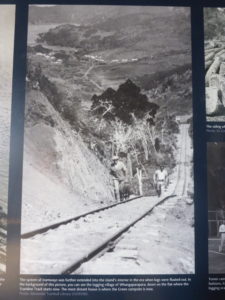
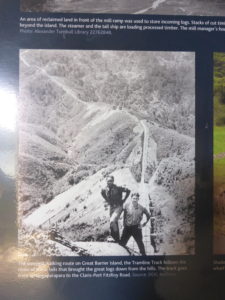
From what I can tell there were two waves of kauri extraction before there were virtually none left. The first started as I said in the 1840’s and may have continued until the First World War interrupted it and the second period of logging was from 1920 until the last raft was towed away to Auckland in 1941.
The immense Kauri Timber Company mill at Whangaparapara was in operation from 1909 to 1914 and processed logs from the Northland area around the Coromandel and Bay of Islands. All that now remains of the mill is a few stumps from the foundations and the concrete slip and quay area.
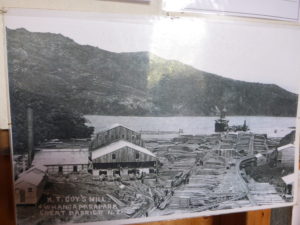
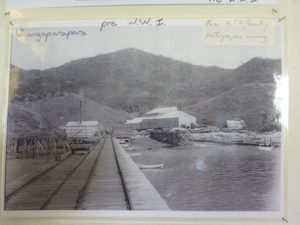
We rowed over there and discovered the slip up which whales were hauled for processing from the 1950’s until 1962. The mill manager’s house used to be located here but was later floated across the bay to become part of what is now the Great Barrier Lodge at which we had a very nice evening meal with Rod and Helen from Whangarei whom we had met on one of our island walks.
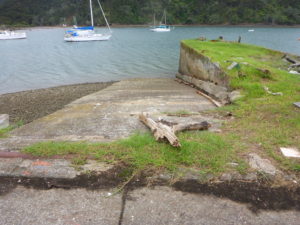

Briefly back to the concrete slip. At the top was painted the gridlines of a tennis court, lovingly restored I imagine by the couple who live there permanently moored up in their big sailing catamaran.

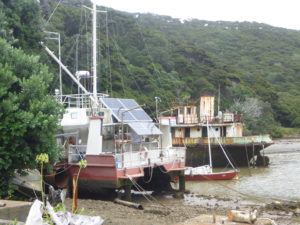
Back in the prosperous Edwardian times the mill ladies in their elegant crinolines would walk along the wooden quay from the mill to play the recently introduced game of tennis and socialise. The catamaran couple are very happy to live there amidst their thriving vegetable gardens dotted around in makeshift raised beds using anything useful they can find. Where once whales’ blood drained down the concrete gulleys to the water now rainwater is collected for her garden.
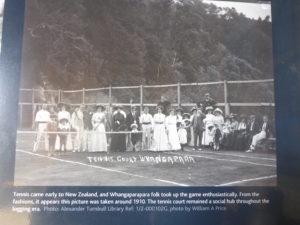
We embarked on the Hot Water Springs loop on the morning of our anniversary. Up the dusty road and over the island divide towards the east coast and then off to the left and through the wetlands. We had just finished our solitary lunch at the springs when three Auckland lads arrived and we chatted just as we did with the Auckland ladies. Then upwards from the bubbling water over bridgeless streams to the tramway accompanied by tuneful tui and friendly fantails that fly directly towards you sometimes.
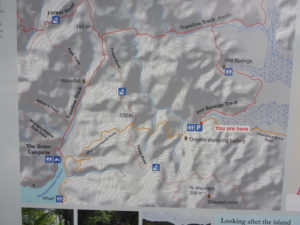
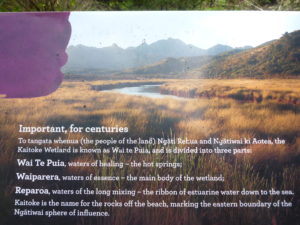
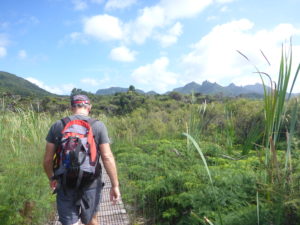
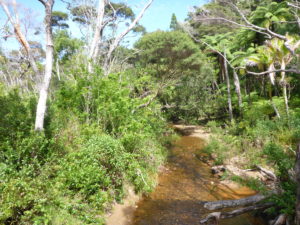
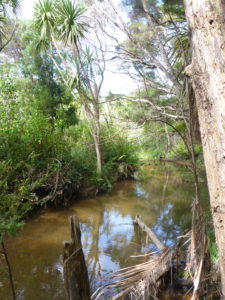
The terrain was moderate to hard where the tramway had once been and down one long descent the groove down which the cable passed to lower the heavy kauri logs under control was the only evidence left. Almost all the rails and sleepers have gone along with most of the bridges.
A stick insect scuttled across our path and a rat continued its fungus lunch undeterred as we passed.
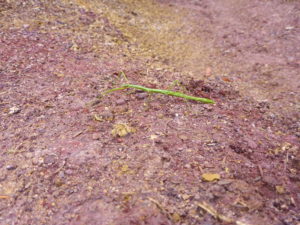
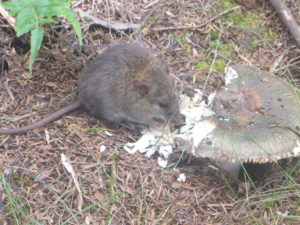
We did around 20km that day and with a forecast of high winds for the end of the week we backtracked north to Port Fitzroy tucked in behind Kaikoura Island the next day, our passage south to the Coromandel thwarted by the weather.

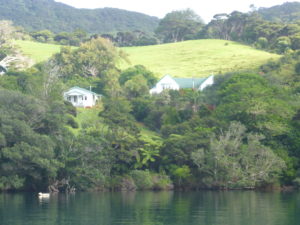
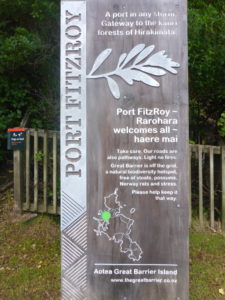
Aotea (Great Barrier Island) by Road
I knew we were being watched as soon as I awoke to the sound of squawking Kaka. Someone or something was aboard with us. Looking up from where I lay in bed the very beady eye of a red beaked seagull standing on top of the bimini was peering in at us through the rectangular crack made by the open hatch cover and its frame. I report this because it kept looking in, looking away and then looking back at me. “Come on lazy bones, time to get up.”
Our little white car had a rear seat passenger in the form of a punctured wheel, taken from another hire car. We had volunteered to drop it off at the garage in Claris for its repair, secretly in the hope the man might drop a little off the exorbitant cost of the daily hire rate. He didn’t.
It was 8.00am and we were going to make the most of every dollar spent. The key was left under the front seat and the tank was full, all ready for us. The owner lived 30 minutes away up a gravel track and the island was as safe from theft as places we know used to be when I was a lot younger.
After dropping off the wheel we ventured into the little Milk, Honey and Grains Museum where the displays were housed in three wooden garden sheds linked together. I will let the photos speak for themselves. The curators clearly had well developed senses of humour.
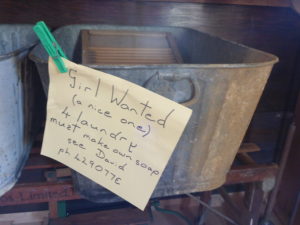
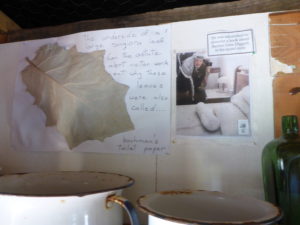
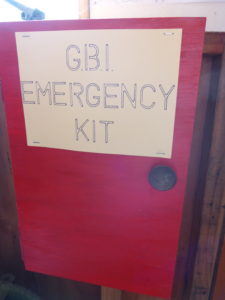
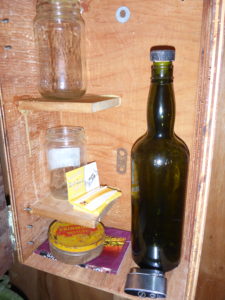
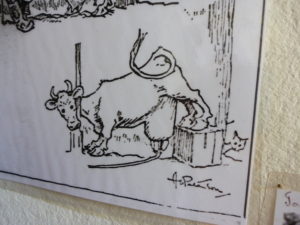
Had we not been thwarted in our plans by the distant and approaching Cyclone Hola we would have anchored in Tryphena Bay, the wide bay near the southern tip of the island, ready to head off to the Mercury Island area and on down the Coromandel Peninsula, so we visited the bay by road instead. The car ferry cat came in as we watched and some folks debunked into fishing boats for a few hours of relaxation. A sizeable artic drove off the ferry, “No way,” I said, looking at the short tight bend at the far end of the shore road.
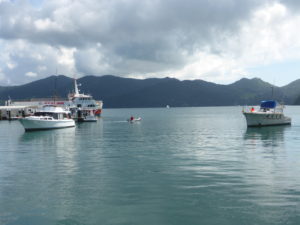
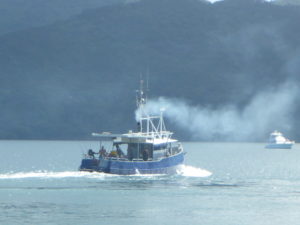
Much smaller lorries pulled up alongside and started transferring his load.
The day was beautiful and we sat at a shaded table overlooking another bay for lunch in the company of some very pretty Banded Rail birds (Mohu Pereru and sparsely distributed).
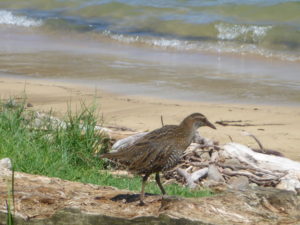

The tyre would not be repaired in time for us to take it back to Fitzroy because the mechanic hadn’t turned up.
At remote horse shoe shaped Whangapoua Bay there is a very big and old Pohutukawa Tree. Within its shade are two neat white picket fences (a favourite form of fencing of the Maoris as well as the Europeans) surrounding the unmarked mass graves of some of the 120 souls who drowned when the S. S. Wairarapa was wrecked through a serious navigational error in 1894. The Maoris helped with the respectful burial of the unfortunate folk.

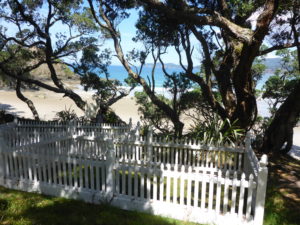
On the beach just beneath the graves was the body of a little blue penguin which I photographed simply so you could see what they are like. They have had a very poor year with the king tides and storm surges flooding their burrow nests so that there are virtually no young in the area this year. But then hopefully nature can recover from such hard times.
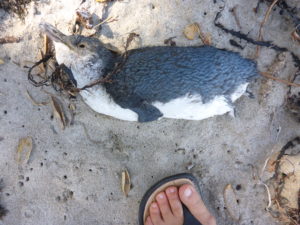
We explored the far end of the beach, watched a wet suited family playing in the surf and lay back and relaxed. White ringlet rollers kissed the beach with a sigh after their long South Pacific crossing. Autumn leaves were falling from our Pohutukawa and I spied Sacred Kingfishers darting purposefully here and there when I did open my eyes.
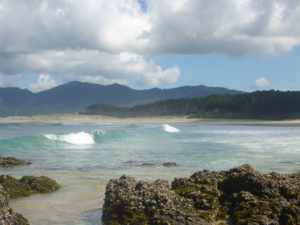
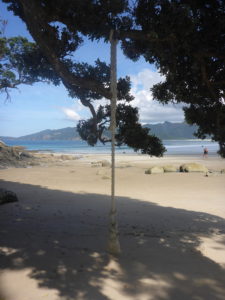
Our last stop would be at the Motairehe Marae where Maori families still live and Pakeha (descendants of Europeans) appear to have been accepted. An idyllic (in good weather) estuary where a handful of black haired children, fresh back from school, climb around the play area.
We had nine and a half hours exploring and returned to Zoonie ready for refreshment, relaxation and another couple of episodes of ‘the Sopranos’, care of Jonty and Jenny.
From Port Fitzroy back to the Main
I think it was partly the radio broadcaster’s mention of the words ‘Cyclone Hola’ that made Rob and I realise the protection of Kaikoura Island (Selwyn Island) between this narrow inlet at Port Fitzroy and the Hauraki Gulf might not be enough to keep Zoonie safe.
Devastation could easily come from the opposite direction over the land. Heavy rain and serious winds will cause trees to tumble and fall on top of each other up the steep hillsides. If and when these reach the water they can cause havoc to small vessels. But we really didn’t want to leave and return to civilization. We had a couple of days before we should up anchor. There were two things left we wanted to do. First the bush walk to the waterfall and second a stroll through the Glenfern Sanctuary where the wanderer is promised a glimpse of what a New Zealand Forest should look like.
The little green DOC sign told us we had a 15 minute walk ahead of us to the waterfall. We were both wearing sandals and it was raining, but the rain was so warm and refreshing who cared. It was a lovely soggy walk, Tui were singing in the rain bless them. I was reminded of our muddy rainforest walk in Guadeloupe where the warm mud oozed up between our toes. Do you, dear reader, remember the massive leaf I found there, big enough to wear as an apron? Well there were lots of generously round leaves here, not quite so big, but you can see why they were the Andrex of the forest men!
I think the rangers must have numeracy issues as 50 minutes later we arrived at the falls, a modest and pretty affair watched over by two of the remaining kauris. We squelched back to Fitzroy well happy with the exercise.
During our stay there Rob had donned his wetsuit and scraped the entire deeply encrusted Whangarei River growth off Zoonie’s hull so we were looking forward to a return to her usual slippery performance on our way back.
We sat in her cockpit on our last evening there. The Glenfern Sanctuary walk will join our reasons to return, just as have other desirable experiences in other wonderful places. All was very quiet, pigeons making rapid ascents for the pleasure of gliding downwards, white chested shags watching from tree branches looked like candles. Hillsides became black and silhouetted and the sky paled into mother of pearl pink and blue and we were just grateful we had enjoyed a fortnight on this magical island.
March 9th 2018. There was little wind as we motored into the Hauraki Gulf the next morning. Little Barrier Island welcomed Zoonie while she made nice progress past, her hull clean and uncluttered. Way back in the 1890’s the island was given the status of a Nature Reserve to protect the fauna, so even then the government knew there was a need to preserve some of New Zealand’s natural countryside while the sound of thundering logs could be clearly heard just across the water.
Offshore we picked up a very nice south easterly and Zoonie sailed under full rig towards the distant craggy shadow of Bream Head. Bream Bay was so named by Captain Cook as his capable crew caught between 90 and 100 bream while the Endeavour was anchored there on Christmas Day 1769. Surprisingly he made no reference to the significance of the day in a number of years of travel finding most religions were dark and incomprehensible especially to those who professed them. Like Cook I prefer to look from the outside in when it comes to religion but I imagine some of his crew might have felt the need to acknowledge the day.
Cook measured the distance directly across this bay between Bream Head and Bream Tail and found it to be 5 leagues. A league is 3.4 land miles and 3.00 nautical miles so his distance was 15 nautical miles, I make it about 12 nautical miles and almost 20 following the shoreline.
Under the blue skies with the perfect 12 to 15 knot wind it was difficult to believe a third cyclone was bearing down upon New Zealand’s shores in what appears to be becoming a pattern of fortnightly intervals. There is yet another storm showing on our Grib files for the end of this week.
This post La Nina weather is proving very destructive not only for humans but also for wildlife. Their food supplies, small fish and krill are un-used to the rising water temperature and so are being forced further offshore. Thus seabirds are having to travel further offshore to feed. Along with this year’s brood of eggs having been destroyed they are very stressed and a sharp decline in numbers is pretty inevitable.
The upper sea temperature in the Tasman off the west coast is 10 degrees above the norm for this time of year and as cyclones feed on warm water the season is likely to be extended, converging on the onset of the NZ winter and reducing our weather window for making the journey north. We shall see.
Hanging from one of the handrails above the table in the saloon we have a little globe and on it New Zealand is so far down and away from Europe it looks as if it is just clinging on and the climb north appears tremendous.
Cook knew nothing of cyclones, he did know the seasons are reversed between the north and south hemispheres and I imagine he had a barometer on board but without the advantage of weather forecasting in the 370 ton 106 foot long Endeavour he simply dealt with what came along. No doubt some of the severe gales he wrote of in his coastal surveying at this time of year were cyclones. His seamanship and mutual trust in his men and anchors must have contributed to their survival and of course the fact that Endeavour was a flat bottomed collier who could take a sandy beach, but preferably intentionally and not one covered with rocks.
Writing summaries on the aspects of New Zealand that he had experienced and pondered upon, Cook goes into detail about the agricultural and mining potential of this fertile and bountiful land. I wonder to what extent it was his findings that inspired the government and early entrepreneurs to send immigrants here (pakeha) to start the wholesale exploitation that is now everywhere for us to see.
Hello Hola. 12th March 2018.
As I type Hola is offloading its heavy load down the east Northland coast. We are snug in our warm dry home, slippers on, but it was not like this a year ago to the day when Zoonie had water up to her saloon seats and a team of neighbours worked hard with buckets to stop her from going any further down to the riverbed while we waited on the South Island for the next car ferry back across Cook Strait to Wellington. Much water has passed under the bridge (literally and metaphorically) since, as you well know.
